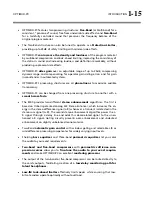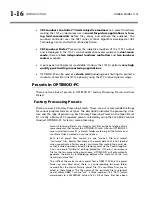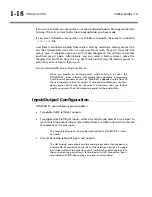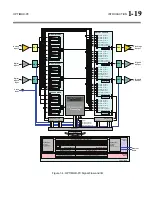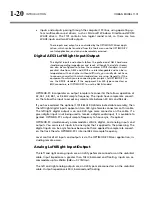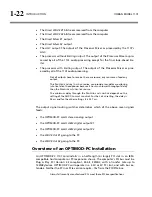
OPTIMOD-PC INTRODUCTION
1-29
guarantee that equipment that can accept an AES3 signal can also accept
a S/PDIF signal. (OPTIMOD-PC can accept both.)
Moreover, the metadata carried in the AES3 bitstream is different from
the metadata carried in the S/PDIF bitstream. The details are beyond the
scope of this manual but can be easily searched on the Internet.
Problems can arise in adapters designed to convert the balanced AES3
signal so that it can be applied to a S/PDIF input or vice-versa. If the AES
transmitter or receiver is transformer-coupled (as is required by the stan-
dard but sometime ignored in practice), pin 3 of the XLR connector re-
ceiving or emitting the AES3 signal must be grounded to unbalance the
AES3 cable. However, if you are connecting an AES3 output to a S/PDIF
input and the AES3 driver does not use a transformer, grounding pin 3
risks shorting one side of the balanced AES3 line driver.
If the netcasting servers are located remotely, then there is a particular advantage to
transporting the compressed stream instead of the raw PCM. If the data rate of the
compressed stream is less than 128kbps, it can be transported on an ISDN line. If the
rate is greater, or if more than one stream is being transported, a fractional T1 line
is often suitable. In general, IP connection via the Internet is insufficiently reliable
for “broadcast contribution quality” connections, introducing a risk of gaps and
dropouts in the stream. Therefore, it is desirable to use an encoder (such as
OPTICODEC-PC) that can automatically reconnect to the server in the unlikely event
that the connection is dropped.
Genlocking OPTIMOD-PC Cards to a Reference Sample
Frequency
Many facilities have a reference sample frequency to which all digital equipment is
locked. Using its ClockLock™ circuitry, OPTIMOD-PC can lock to external references.
Each AES3 Digital Input can derive a reference sample frequency from an AES3 or
AES11 signal at its input. The Word Clock input can accept a 10MHz reference signal
as well as 1x word clock at 32, 44.1, 48, 88.2, or 96 kHz. Via the
D
IGITAL
C
LOCK
R
EFERENCE
control, OPTIMOD-PC’s output sample frequency can be locked to any of
these references or to its internal crystal oscillator. [See step (4.B) on page 2-24,
Figure 1-4 on page 1-19 and
on page 1-24.]
Regardless of whether the 1101 is locked to an external reference or its internal crys-
tal oscillator, you can freely set the output to 32, 44.1, 48, 88.2, or 96 kHz—the
locked output sample frequency does not have to be the same as in the reference
sample frequency. For example, if the reference sample frequency is 32 kHz and the
output sample frequency is set to 48 kHz, the actual output sample frequency will
be exactly 48/32 x the reference sample frequency.
If the input reference sample frequency deviates from 32, 44.1, 48, 88.2,
or 96 kHz by more than ±0.05%, the output sample frequency will lock
automatically to OPTIMOD-PC’s internal crystal reference instead of the
input reference.
In all cases, OPTIMOD-PC’s internal processing operates at 48 kHz, locked
to the reference set via the
D
IGITAL
C
LOCK
R
EFERENCE
field in the I/O
Summary of Contents for Optimod-PC 1101
Page 4: ......
Page 14: ......
Page 121: ...OPTIMOD PC OPERATION 3 1 Section 3 Operation Figure 3 1 The OPTIMOD PC Control Application...
Page 192: ...3 72 OPERATION ORBAN MODEL 1101...
Page 204: ......
Page 210: ......
Page 212: ...5 2 UNINSTALLATION ORBAN MODEL 1101...
Page 236: ......

